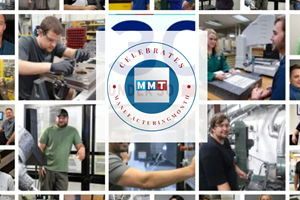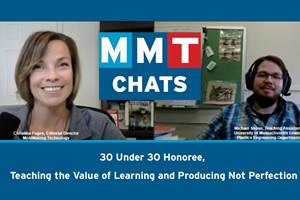Got Students? A-1 Tool Says Bring ‘Em On for MFG Day!
Shop tours abounded for A-1 Tool Corp., which hosted more than 188 students on Manufacturing Day and beyond.
Did you know that the concept of injection molding plastic had its beginnings in the 1870s, when a man named John Wesley Hyatt developed celluloid as a material for making billiard balls from something other than ivory? On Manufacturing Day, which was October 4, more than 188 high school students and their teachers learned this interesting piece of history and more when they toured A-1 Tool Corp. (Melrose Park, Illinois). Groups of 40 students at a time were led through the shop, stopping at each station (or department) to learn about how molds are made. The company hosted another group of 40 high school students on October 22.
Did you know that a billiard ball heralded the birth of injection-molded plastic?
I asked Greta Salamando, outreach and enrichment coordinator, who organized the tours and Joe LaMonica, CFO, and Mike Alesi, project manager, each of whom escorted the visitors through the shop, to share some observations from that day.
“It was hard to get that many kids scheduled to get in and out of here,” Salamando says. “Some schools were visiting more than one company and had less time to see everything. We are a big company and we have a lot that we wanted to show them, so we had to cut presentation times down to 15 minutes in each department.”
LaMonica says he feels the shorter presentations provided the right level of information to spark the students’ interest. “For example, if you go too deep into explaining how our FTP Dino has three different heads for milling and how many RPMs each head can handle and metal removal rates, you’re going to lose their attention because it doesn’t mean anything to them,” he says. “What they get excited about is how big the chips are that are flying off the machine and are they making sparks as they fly off. They want to know what that liquid is that is getting sprayed onto the workpiece.”
The video above was one of a few presented to students who toured A-1 Tool Corporation on MFG Day 2019.
An Unprecedented Turn Out
Salamando, who worked previously at the Technology and Manufacturing Association (TMA) in Schaumburg, Illinois, and acted as a liaison to bring manufacturers and leaders in education together (among other things), says the turnout at A-1 is unprecedented. “We had to turn schools away because it was just too many,” she says. “We started at 8:30 a.m. that morning and didn’t stop before about 2:30 p.m. For a lot of companies, bringing 40 kids at a time into their facilities is difficult. When I was at TMA, many companies said they could handle maybe half that number. We’re lucky that we are a larger company and we could split each group into four quadrants, 10 students to each segment of the tour.”
We had to turn schools away because it was just too many.
She adds that A-1 did not want to have groups larger than 10 to 15 students in each quadrant because if the number gets too big the kids lose focus. “They can’t hear well, and they can’t get close enough to actually see, up close, what we are trying to show them.”
LaMonica points out that the reason for the overwhelming turnout on MFG Day was not because A-1 is a larger company, but because Salamando orchestrated the event and more school districts are re-investing in manufacturing-related curricula again.
Salamando concurs, saying, “One of the schools we hosted was York High School, for instance. This is their first year having a manufacturing program, and I know more schools are getting on board. I think it helped bring more attention to Manufacturing Day and manufacturing careers.”
Using A Direct Approach to Promote Tour and Team Participation
“One of the things that I did differently than maybe other companies would do is I actually contacted schools within a 15-mile radius of us and sent them e-mails,” Salamando says. “I also sent them a letter saying we'd like to see you for Manufacturing Day.” She concedes that before this can be done, companies need to have someone on staff who can dedicate time to reaching out to schools and following up with them. “It helps to have videos already made like we do, and a team that wants to help organize the tour and pick out highlights in each department that can be shown to students. You have to let everyone know that it is an important day, participation is needed and make it a priority.”
Setting It Up Right
LaMonica says that a successful tour requires the right resources. “The guys here did a great job of staging molds and staging products so that the tour was more interesting because you could actually see specifically what we're talking about as opposed to being hypothetical,” he says. “We had a mold for a dishwasher console split open and parts on the cavities so they could see how the parts are formed.”
“Mike Alesi started a molding press up so they could see a mold in action,” Salamando adds. LaMonica says the students loved seeing the mold pumping out parts and feeling the hot parts as they were ejected. “Everyone’s favorite thing was sticking their hands in the raw plastic,” he says. “They are tactile learners, so they like to touch things and experience them firsthand.”
Everyone’s favorite thing was sticking their hands in the raw plastic.
As for what seemed to garner the biggest reactions and questions from the students, Alesi says, “Most of the time you have to prod them. They're kind of quiet. There's a lot of discussion going on, on our part as the tour guides, explaining what things are and what they do. But then they start to open up a little bit.” He says some questions centered around the cost of building a mold and how much profit is made from it.
Because timeframes were rather tight, there was not a lot of time at each stage of the tour to take many questions. But all agreed that the students and teachers were impressed by what they saw and given more time, may have had more questions. “It was a lot of information to download in a short time,” LaMonica says.
I told them they will never look at plastic products the same way again.
“I know during my part of the presentation, I would have them look at plastic parts – things that they could relate to in their everyday lives – and ask if they could find where the plastic went in, where it was ejected from and I asked if they could find those spots on the designs,” Salamando says. “I told them they will never look at plastic products the same way again.”
LaMonica and Alesi each listed out some moments from the tours that were notably “aha moments” that the students experienced. Here are a few:
- That injection molding all started with billiard balls.
- Realization that the model plane part runners actually had a purpose.
- Impressed with the complications and details required to make a functioning mold.
- Most liked looking for the sprue indicator and the pusher pin marks, once they understood their purpose.
- They also really seemed to like watching the machines operating, cutting chips.
- Loved watching the mold operate, including the feeling the temperature of the products coming out of the mold. Also liked the robotic arm used in the molding process.
- And of course, everyone’s favorite… running their fingers through the raw plastic pellets.
- Impressed by the cleanliness of the shop…compared to our competitors.
- Diamond-polished surfaces
- Loved the workout room and sauna
- The 3D viewer
Each student left with a molded box filled with some A-1 branded goodies – boxes they watched being molded.
Salamando says everyone at A-1 felt the event was very successful and they would host more tours in the future. “A lot of high schools do a field trip in the fall and then a field trip in the spring, so I'm willing to take them any time of the year!” she says.
Related Content
30 Under 30: The New Face of Moldmaking
Young professionals are vital to the moldmaking industry, and it is important to acknowledge those making strides in shaping the industry's future. MoldMaking Technology recognizes the industry's young talent through its inaugural 30-Under-30 Honors Program.
Read MoreWomen Impacting Moldmaking
Honoring female makers, innovators and leaders who are influencing our industry's future.
Read MoreICYMI, MMT Chats: 30 Under 30 Honoree, Plastics Engineering TA Teaches Value of Learning and Producing Not Perfection
MoldMaking Technology Editorial Director Christina Fuges brings on UMass Lowell Plastics Engineering Teaching Assistant Michael Shone as a guest for this MMT Chat to discuss moldmaking through the lens of academia. This episode is brought to you by ISCAR with New Ideas for Machining Intelligently.
Read MoreFrom Injection Mold Venting to Runnerless Micro Molds: MMT's Top-Viewed June Content
The MoldMaking Technology team has compiled a list of the top-viewed June content based on analytics. This month, we covered an array of topics including injection mold venting, business strategies and runnerless micro molds. Take a look at what you might have missed!
Read MoreRead Next
How to Use Continuing Education to Remain Competitive in Moldmaking
Continued training helps moldmakers make tooling decisions and properly use the latest cutting tool to efficiently machine high-quality molds.
Read MoreHow to Use Strategic Planning Tools, Data to Manage the Human Side of Business
Q&A with Marion Wells, MMT EAB member and founder of Human Asset Management.
Read MoreReasons to Use Fiber Lasers for Mold Cleaning
Fiber lasers offer a simplicity, speed, control and portability, minimizing mold cleaning risks.
Read More.jpg;maxWidth=970;quality=90)







_300x250 3.png;maxWidth=300;quality=90)







.jpg;maxWidth=300;quality=90)













